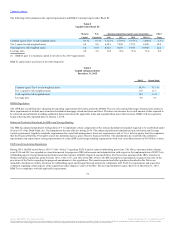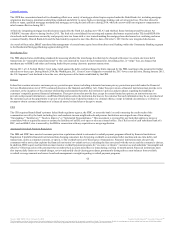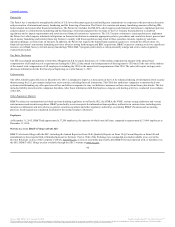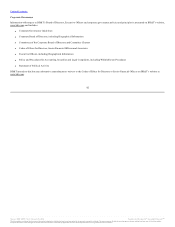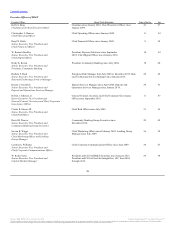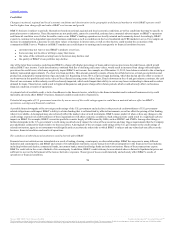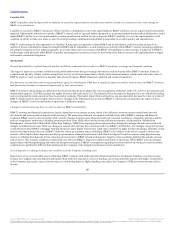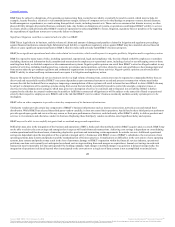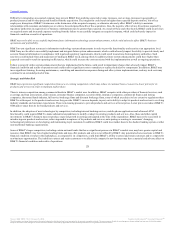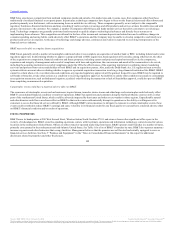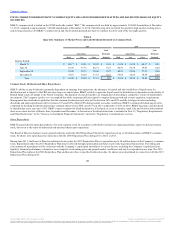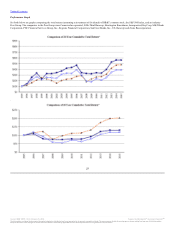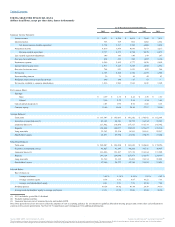BB&T 2015 Annual Report Download - page 24
Download and view the complete annual report
Please find page 24 of the 2015 BB&T annual report below. You can navigate through the pages in the report by either clicking on the pages listed below, or by using the keyword search tool below to find specific information within the annual report.
TableofContents
Liquidity Risk
BB&T’s liquidity could be impaired by an inability to access the capital markets, an unforeseen outflow of cash or a reduction in the credit ratings for
BB&T or its subsidiaries.
Liquidity is essential to BB&T’s businesses. When volatility or disruptions occur in the capital markets, BB&T’s ability to access capital could be materially
impaired. Additionally, other factors outside of BB&T’s control, such as a general market disruption or an operational problem that affects third parties, could
impair BB&T’s ability to access capital markets or create an unforeseen outflow of cash or deposits. BB&T’s inability to access the capital markets could
constrain its ability to make new loans, to meet its existing lending commitments and ultimately jeopardize its overall liquidity and capitalization.
BB&T’s credit ratings are also important to its liquidity. Rating agencies regularly evaluate BB&T and its subsidiaries, and their ratings are based on a
number of factors, including the financial strength of BB&T and its subsidiaries, as well as factors not entirely within BB&T’s control, including conditions
affecting the financial services industry generally. As a result, there can be no assurance that BB&T will maintain its current ratings. A reduction in BB&T’s
credit ratings could adversely affect BB&T’s liquidity and competitive position, increase its borrowing costs, limit its access to the capital markets or trigger
unfavorable contractual obligations.
Market Risk
Turmoil and volatility in global financial markets could have a material adverse effect on BB&T’s operations, earnings and financial condition.
The negative impact on economic conditions and global markets from foreign sovereign debt matters could adversely affect BB&T’s business, financial
condition and liquidity. Global conflicts and political activity could cause turmoil and volatility in the financial markets, which could reduce the value of
BB&T’s assets or cause a reduction in liquidity that adversely impacts BB&T’s financial condition and results of operations.
The monetary, tax and other policies of governmental agencies, including the FRB, have a significant impact on market interest rates, and BB&T’s business
and financial performance is impacted significantly by such interest rates.
BB&T’s businesses and earnings are affected by the fiscal and other policies adopted by various regulatory authorities of the U.S., non-U.S. governments and
international agencies. The FRB regulates the supply of money and credit in the U.S. The federal policies determine in large part the cost of funds for lending
and investing and the return earned on those loans and investments. The market impact from such policies can also materially decrease the value of certain of
BB&T’s financial assets, most notably debt securities. Changes in the federal policies are beyond BB&T’s control and, consequently, the impact of these
changes on BB&T’s activities and results of operations is difficult to predict.
Changes in interest rates may have an adverse effect on BB&T’s profitability.
BB&T’s earnings and financial condition are largely dependent on net interest income, which is the difference between interest earned from loans and
investments and interest paid on deposits and borrowings. The narrowing of interest rate spreads could adversely affect BB&T’s earnings and financial
condition. BB&T cannot control or predict with certainty changes in interest rates. Regional and local economic conditions, competitive pressures and the
policies of regulatory authorities, including monetary policies of the FRB, affect interest income and interest expense. As discussed in “Market Risk
Management – Interest Rate Market Risk (Other than Trading),” BB&T has ongoing policies and procedures designed to manage the risks associated with
changes in market interest rates. However, changes in interest rates still may have an adverse effect on BB&T’s profitability. For example, rising interest rates
could adversely affect BB&T’s mortgage banking business because higher interest rates could cause customers to apply for fewer mortgages. Similarly, rising
interest rates may increase the cost of BB&T’s deposits, which are a primary source of funding. BB&T is also subject to the risk of a negative interest rate
scenario, which implies that a depositor would pay a premium for a financial institution to hold funds on deposit. In such a scenario, some depositors may
choose to withdraw their deposits in lieu of paying an interest rate to BB&T to hold such deposits. Negative rates would also diminish the spreads on loans
and securities. This scenario could have a material adverse effect on BB&T’s financial condition and results of operations. While BB&T actively manages
against these risks through hedging and other risk mitigation strategies, if BB&T’s assumptions regarding borrower behavior are wrong or overall economic
conditions are significantly different than anticipated, the Company’s risk mitigation techniques may be insufficient.
Loss of deposits or a change in deposit mix could increase the Company’s funding costs.
Deposits are a low cost and stable source of funding. BB&T competes with banks and other financial institutions for deposits. Funding costs may increase
because the Company may lose deposits and replace them with more expensive sources of funding, clients may shift their deposits into higher cost products
or the Company may need to raise its interest rates to avoid losing deposits. Higher funding costs reduce the Company’s NIM, net interest income and net
income.
20
Source: BB&T CORP, 10-K, February 25, 2016 Powered by Morningstar® Document Research℠
The information contained herein may not be copied, adapted or distributed and is not warranted to be accurate, complete or timely. The user assumes all risks for any damages or losses arising from any use of this information,
except to the extent such damages or losses cannot be limited or excluded by applicable law. Past financial performance is no guarantee of future results.



